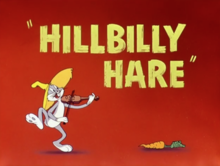| Hillbilly Hare | |
|---|---|
 | |
| Directed by | Robert McKimson |
| Story by | Tedd Pierce |
| Produced by | Edward Selzer |
| Starring | |
| Music by | Carl Stalling |
| Animation by |
|
| Layouts by | Cornett Wood |
| Backgrounds by | Richard H. Thomas |
| Color process | Technicolor |
Production company | |
| Distributed by | |
Release date |
|
Running time | 7:22 |
| Language | English |
Hillbilly Hare is a 1950 Warner Bros. Merrie Melodies cartoon directed by Robert McKimson. [2] The short was released on August 12, 1950 and stars Bugs Bunny. [3]
